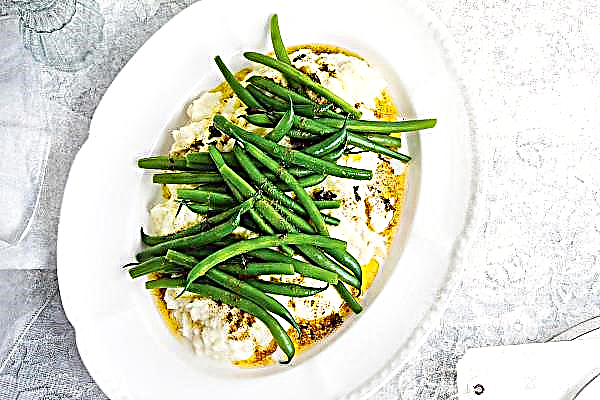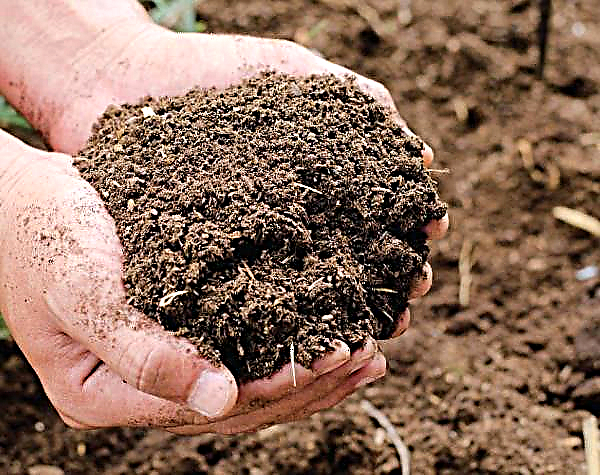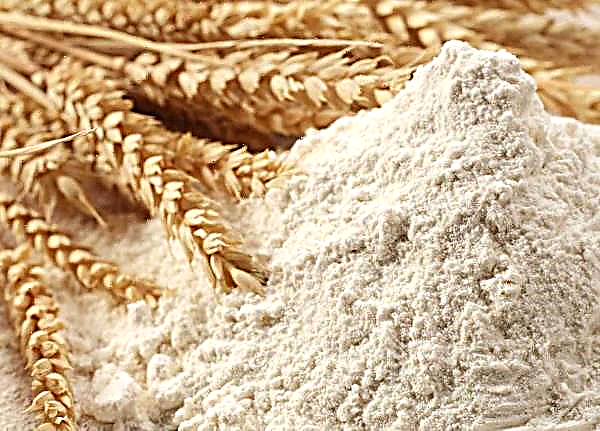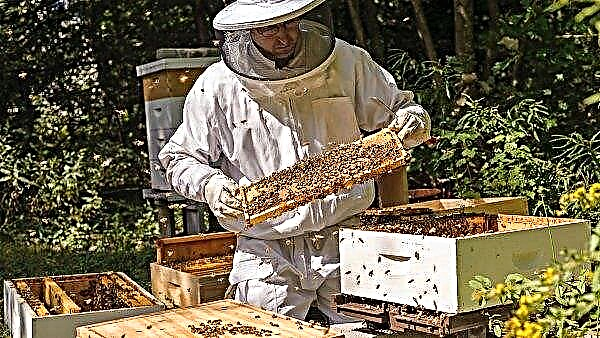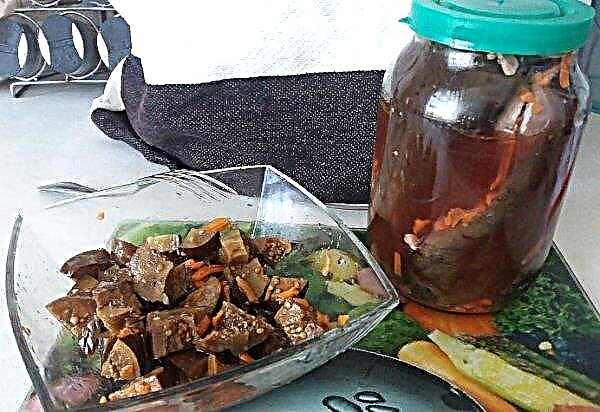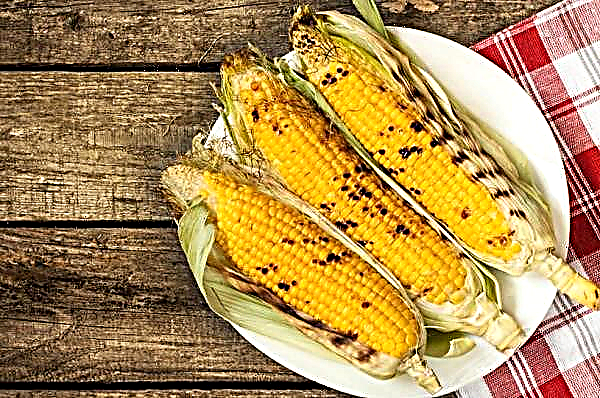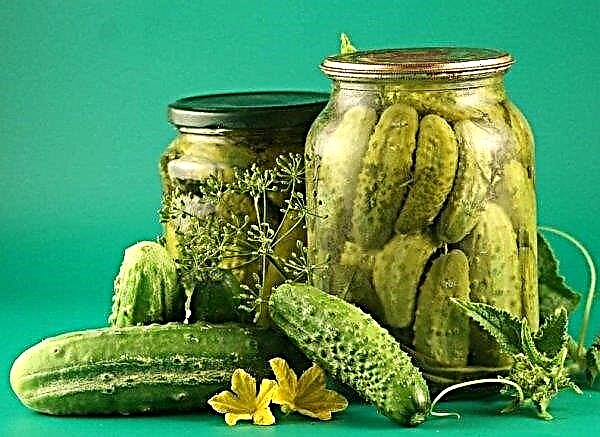Climbing roses are popular and in demand in landscape gardening. With their help, you can create a beautiful hedge, a recreation area, decorate the fence, wall or part of the house. But in order for roses to flourish and fulfill their decorative function, they need competent pruning at the end of the season. Why prune a climbing rose for the winter, and how to carry out the procedure correctly - read more about this later.
Why do you need pruning?
A novice gardener may have a question: is it necessary to cut a climbing rose for the winter, and why do this if the main value of the plant is in the length of the shoots?
Firstly, after pruning, the shoots begin to grow more intensively, but in addition, with the help of correct winter pruning, they solve a number of other problems:Did you know? Climbing roses are record holders for the growth rate of shoots. In warm climates, their lashes can grow up to 10 m per season.
- simplifies the process of sheltering the bush for the winter;
- shortening the tops of the lashes stimulates the growth of new shoots and flower buds;
- thinning of excess branches provides uniform lighting and airing of the bush;
- a more rational distribution of nutrients occurs;
- the root system is strengthened, which contributes to better growth and abundant flowering of roses;
- removal of damaged and diseased shoots increases winter hardiness and resistance of the bush to diseases;
- rejuvenation of the plant occurs - regular replacement of old branches with new shoots prolongs the life and productivity of the bush;
- as a result of pruning, quality material appears for further propagation of the favorite variety;
- pruning helps to form a bush and direct the shoots in the right direction, resulting in maximum decorative effect.

How to prune a climbing rose for the winter?
The procedure for pruning a climbing rose is simple, but it is worthwhile to observe the correct time, have the necessary equipment and know the rules for such a procedure.
The timing
Bushes with climbing shoots begin to prune from the second year after planting. For autumn pruning, you should wait until the night temperature stably holds at –3 ...– 5 ° C for several days. In the middle lane, this happens around the end of October. By this time, the shoots will mature enough, and a little frost will temper them before winter.
Pruning can not be done before, since in warm weather shoots continue to grow, and if they do not have time to numb, then they will die in winter. To stop the growth of the bush, in July you need to stop applying nitrogen fertilizers and increase the fertilizing with potassium and phosphorus. This complex contributes to the maturation of lashes and the strengthening of rhizomes, which is required for a successful wintering.
Cutting equipment
To trim, you will need the following tools and equipment:
- a well-sharpened garden knife or secateurs - it is preferable to use a secateurs, since after it the cut is more even;
- garden saw - may be needed to cut large woody branches;
- tight work gloves that protect hands from spikes;
- garden rake to collect scraps and dry leaves;
- alcohol or other tool disinfectant;
- means for processing slices: garden var, potassium permanganate solution, copper sulfate.
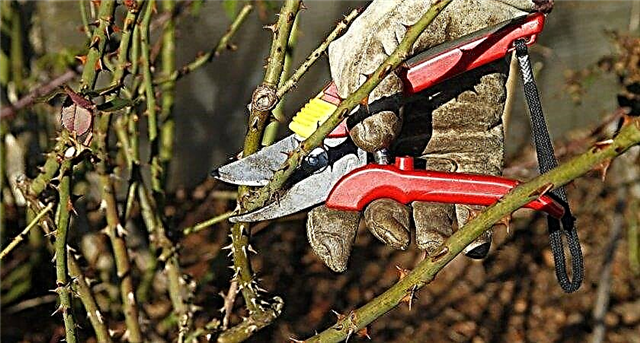
Important! Before starting the procedure, disinfect all instruments and make sure they are sharp, as an imperfectly smooth cut can cause infection.
Pruning rules
The pruning method depends on the length of the shoots, the size of the bush, and other varietal features, but there are general rules that apply to all varieties of climbing roses:
- pre-winter pruning is carried out in dry and sunny weather - this is a necessary condition for the speedy healing of slices;
- the bush is shortened by a third of the volume, and the shoots are directed so that the rose rises above the surface by 30–40 cm, otherwise it will be difficult to cover;
- first, the bush is sanitized - dry, moldy, damaged and old unproductive shoots are cut to the base (they will still freeze and become a source of infection);
- then secateurs remove small branches directed inward and leading to thickening of the bush;
- if a young shoot has formed at the roots, it must be cut to the base - these are “wild” unproductive shoots that can lead to the “bush” of the whole bush;
- the slice is performed at a slope of 45 ° at a level of 0.5–1 cm above the kidney, located on the shoot from the outside;
- during pruning, leaves and dried buds are removed - even if it is impossible to remove all the foliage, remove at least the lower leaves, since they can become the source of the spread of diseases;
- after pruning, 5–7 young shoots of the current year should remain on the bush, forming a uniform crown.
Video: how to cut a climbing rose
As already noted, the method of pruning a climbing rose is determined by its varietal characteristics.
Did you know? Climbing roses need support, because they do not have special suction cups and antennae, like other weaving plants. They can cling to spikes, but this is not enough for vertical lifting.
By type of flowering, this species is conventionally divided into 5 groups:
- To the first group include varieties with flowering on last year's side shoots located at the roots (Dorothy, Excelsia). Repeated inflorescences on these branches do not form, therefore, in the autumn they are completely cut out so that later on, young shoots appear on the site of the cuts.

- In the second group Varieties are composed, the flowering of which also occurs on the lateral shoots of the last year (Chaplins Pink, Laguna), but the growth of these shoots is rare. Therefore, in the first year they are cut off completely, and the sprouts formed at this place are shortened by 10-15 cm.

- Third group - varieties with hanging flexible lashes, in which inflorescences are formed from shoots of the current year (floribunda, hybrid tea varieties). The image of such roses is the simplest. After flowering, the shoots are shortened by 15 cm, so that in spring new branches grow from the sides.

- To the fourth group adjoin varieties with small stems growing vertically. Pruning such bushes consists in removing the oldest shoots in order to maintain the symmetry of the bush, and shortening the young lashes by 15 cm.
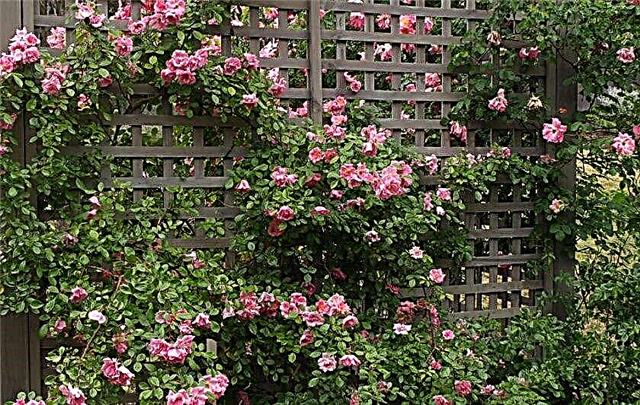
- Fifth group includes ground cover and strong-growing varieties with flexible shoots up to 6 m long (Banks, Vihura). In winter, the lashes of such roses are shortened by 10-15 cm or not trimmed at all if the climate is mild and winter shelter is not required.

Frequent mistakes of beginners
Experienced gardeners do not have problems with preserving roses in the winter, but they happen to beginners who recently began to grow these flowers.
Mistakes in care that may interfere with a successful wintering:
- Intensive shoot growth in autumn. The problem arises with an overdose of nitrogen and complex fertilizers. Sometimes, in pursuit of decorativeness, gardeners too often feed the rose, as a result of which shoots continue to give growth, despite the fact that the yard is autumn.
- Too early pruning. Any pruning stimulates the growth of new buds, and on the eve of winter it is completely undesirable, so you need to wait for the freezing temperature when the movement of juices slows down and the vegetative process stops.
Important! In most regions, roses are sheltered for the winter. If, after pruning, shelter, a rose and the soil in which it grows follow, you need to carefully treat it with a copper-containing fungicide to prevent the development of fungi.
- Pruning all dried buds. In climbing roses, it is recommended to cut off dried inflorescences partially and only at the beginning of the season to maintain decorativeness. Removing the buds at the end of flowering can contribute to the laying of new flower buds, as a result of which the bush will not be able to survive the winter.
- Not all roses can leave leaves. In regions with an unstable temperature and frequent thaws, foliage must be removed, as it is a source of pathogenic fungi, and can lead to decay of the bush. Leaves can only be left on roses wintering in a mild climate without shelter.
- Inadequate slicing. Sometimes gardeners do not immediately process the slices, or even ignore this procedure. Of course, you can take risks and do without fungicides, but is it worth it if your favorite flowers can get sick and die from this?

Whatever varieties of climbing roses grow on the plot, it is recommended to cut any of them for the winter, especially if the winter is long and frosty. Without this procedure, the bush may weaken and not survive the cold period, but if the pruning is carried out correctly, the rose will be renewed and in the spring will please with lush, long flowering.








